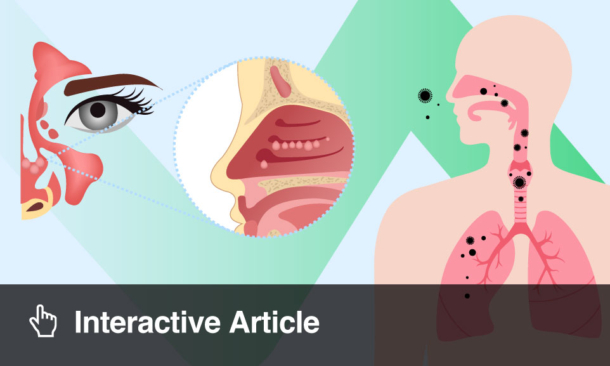Author: Helena Bradbury, EMJ, London, UK
Citation: EMJ Allergy Immunol. 2024;9[1]:20-24. https://doi.org/10.33590/emjallergyimmunol/DYIV6567.
![]()
THE ROLE OF ANTI-IGE IN THE MANAGEMENT OF FOOD ALLERGY
Robert A. Wood, The Johns Hopkins University School of Medicine, Baltimore, Maryland, USA, began by discussing the OUtMATCH (Omalizumab as Monotherapy and as Adjunct Therapy to Multi-Allergen Oral Immunotherapy in Food Allergic Children and Adults) trial, a Phase III trial designed to assess the safety and efficacy of omalizumab for reducing allergic reactions; specifically to peanut, cashew, egg, milk, and walnut.1 As explained by Wood, success in this trial was defined as the ability to consume a single dose of ≥600 mg protein (1,044 mg cumulative) without dose-limiting symptoms for peanut, and ≥1,000 mg protein (2,044 mg cumulative) for cashews, walnuts, egg, milk, hazelnut, and wheat.
Regarding trial design, OUtMATCH spanned three distinct stages, with total enrolment lasting approximately 4 years and 8 months. In the first stage, spanning 16–20 weeks, each participant was randomised to receive biweekly or monthly injections of omalizumab or placebo injection. An oral challenge was then performed, in which participants ingested small quantities of food allergen and researchers closely monitored for any indications of allergic reaction. Following this, some participants (n=60) enrolled in the Open Label Extension, assessing the long-term effects of omalizumab, whilst the remainder (n=61–225) proceeded to second stage. The second stage, spanning 14–15 months, comprised three components; initially all participants received omalizumab injections, biweekly or monthly, for 8 weeks. The cohort was subsequently divided into two groups, one receiving multi-allergen oral immunotherapy (OIT) and omalizumab for 8 weeks, followed by placebo injections for 44 weeks, and the other group receiving 52 weeks of placebo OIT and omalizumab. Based on results of the prior stages, participants would be recommended allergen-containing diets, and their responses monitored, as part of the final stage.1,2
“This was a unique collaboration between NIAID, CoFAR, and industry,” Wood exclaimed. FDA approval of omalizumab was granted on the 2nd February 2024 for “IgE-mediated food allergy in adult and paediatric patients aged 1 year and older for the reduction of allergic reactions, including anaphylaxis, that may occur with accidental exposure to one or more foods.” Wood praised this result, highlighting that this is the first medicine ever approved to reduce allergic reactions to multiple foods following an accidental exposure. The OUtMATCH trial marks a significant advancement in the field of allergy and immunology, combatting reactions to a plethora of allergens.
HOW CAN MANIPULATIONS OF THE GUT MICROBIOME INFLUENCE FOOD ALLERGY?
Susan Lynch, University of California San Francisco, USA, next took to the stage, sharing several compelling facts on the microbiome; 95% of our microbiota is located in the gastrointestinal tract, and there are approximately 1.3 times more microbes than human cells in the body. Referencing a 2023 study, 16S rRNA sequencing, coupled with metabolic analysis, revealed significant differences in the infant faecal microbiomes between those who did, and did not, develop peanut allergies. For instance, infants with a peanut allergy exhibited depletion of Clostridium sensu stricto and elevation of Streptococcus bacterium. Two anti-inflammatory short-chain fatty acids, butyrate and isovalerate, are additionally expressed at significantly greater levels in infants who go on to develop peanut allergies, compared to those who do not.3
Correlation does not equal causation; however, so how do we know these metabolic differences drive allergic conditions? To answer this question, Lynch cited a 2019 study from the Department of Pathology and Committee on Immunology, University of Chicago, Illinois, USA.4 Here, Nagler and colleagues took mice raised without a microbiome, known as germ-free mice, and inoculated them with the faeces of those allergic to cow’s milk. Interestingly, results revealed phenotypic features of the allergy in those inoculated, underscoring the role the microbiome plays in allergy development. Possible factors suspected to influence this process include arachidonic acid, pyruvate, and linoleic acid metabolism. Notably, a significant enrichment of 12,13-diHOME, a lipid product of the linoleic acid metabolism, in the faecal sample of those with an allergy was observed.5
To better understand what caused enrichment of linoleic acid metabolite, Fujimura KE et al.5 performed shotgun metagenomic analysis. Two bacterial species, Bifidobacterium bifidium and Enterococcus faecalis, were found to encode an enzyme responsible for the breakdown of linoleic acid to 12,13-diHOME, known as epoxide hydrolase.5 As highlighted by Lynch, this finding is highly significant as it shows gut microbes directly drive the production of lipids responsible for allergy development. Further research by Nagler and team identified that as the concentration of 12,13-diHOME lipid increases, the frequency of T regulatory cells decreases, as well as their capacity to secrete the anti-inflammatory cytokine IL-10.5
BIOMARKER-DRIVEN APPROACHES TO MODULATE AND EVALUATE NOVEL THERAPEUTICS IN ALLERGIC DISEASES
Mohamed Shamji, Imperial College London, UK, began by summarising the prevalence, clinical symptoms, and management of peanut allergy. Affecting approximately 2% of the Western population, and associated with the highest rates of accidental exposure, peanut allergies are a prominent global health concern. Current recommended management comprises a combination of strict allergen avoidance and having a pre-loaded adrenaline auto-injector (AAI) readily on hand.
Touching on existing treatments, Shamji spoke of treatments such as omalizumab and peanut sublingual immunotherapy (SLIT). As a sublingual therapy, Peanut SLIT medication is placed under the tongue and has shown promise in treating toddlers who are peanut allergic. Despite these efforts, Shamji stressed the unmet need for novel therapeutic innovations.
Virus-like particles (VLP) are nanoscale structures comprising of viral proteins, but are non-infectious as they lack viral genetic material. As highlighted by Shamji, VLPs offer great therapeutic potential for allergic diseases. A novel VLP platform, for example, was recently developed, based on the cucumber mosaic virus and containing tetanus toxoid universal T cell epitope TT830-843, to enhance T helper cell-dependent IgG responses. This vaccination approach was tested in three scenarios: against IL-5 to treat insect-bite hypersensitivity in horses,6 against IL-31 to treat atopic dermatitis in dogs,7 and notably against Fel d 1 in cats to reduce allergic symptoms of owners.8 In all cases, there was a clear reduction in immune reactivity as a result.
Within Shamji’s lab, the VLP-Peanut001 was assessed in ex vivo following a successful pre-clinical phase. Exposing T helper 2 (Th2) cells and dendritic cells, in a dose-dependent manner, to VLP Peanut resulted in a downregulation of transcription factor GATA3 and inhibition of proliferation of Th2 and Th2a cells. This finding is significant as it demonstrates that VLP Peanut can actively lower immune hyperactivity. VLP Peanut promoted significant proliferation of CD19+ B cells, and exhibited reduced ability to induce FcɛRI and FcɛRII-mediated responses.
Based on the ex vivo trial success, the first-in-human Phase I clinical trial, VLP101 (PROTECT), was subsequently launched. Results revealed that VLP Peanut is well-tolerated when given as a skin-prick test, giving hope to a novel therapeutic on the horizon. The trial had two parts. In Part A, healthy adults (n=16) were divided into four groups of four and given increasing doses of VLP Peanut subcutaneously, while peanut-allergic adults (n=6) received increasing concentrations of VLP Peanut via skin prick tests. In the double-blind part, peanut-allergic adults (n=24) were divided into four groups and treated with escalating subcutaneous doses of VLP Peanut or a placebo.
CONCLUSION
Overall, this session presented significant advancements in the management of food allergies, showcasing the evolving landscape of the field, and stressing the potential of both pharmacological and microbiome-targeted therapies to improve patient outcomes.





